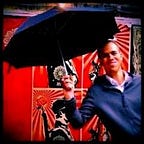European democracy doesn’t feel real or practical because its institutions are not physically present in our daily life. Yet in London and other major cities many Europeans from different countries share the same national political space. So how can we link up Europeans to visualise new forms of democracy in these cities and how we can we link up the “locals” with the other cities to organize transnationally?
Although democracy is organized over very short periods of time, its culture has been embedded for generations, but how can we (re)invent forms of democratic participation. How can we bridge those stories between people of different generations?
There is a sense that our generation is powerless. Yet across Europe, in the past year ,we have witnessed different forms of political mobilization and protest. If the multitude produce social change, what can we learn about social movements and community organizing in increasing awareness and mobilising democratically? What can we from the riots about violence and protest politics?
When we organised festivals as European Alternatives, the main keywords around new forms of democratic participation were powerlessness, role models and love letters followed by happiness, parties, public space, undercover, networks, incentives and maps.
How did we going to develop the issue?
We asked people from all over Europe “what does democracy look like for you?” and help them to articulate their answer t using visualization techniques.
The project would also involve giving artists the challenge to come up with new acts of protest as part of the creative brief for the “Open Call for Ideas” proposed in the Festival Arts Programme.
The creative outputs by the artists would be featured in the Home of the Festival and would be used to get participants to enact a protest activity imagined by artists.
Use of video and social media could be used to film and spread the word of the participants interacting with these outputs, although we would select the type of interaction based on what outputs the artists created.
The main festival techniques people suggested for activities around new forms of democratic participation were creating materials for an activity, followed by walking, having your say, winning prizes and producing documentaries and installations. The most popular types of activities put forward were visuals, workshops and storytelling.
People wanted to involve others through texting each other, having their say, teaching skills, drawing maps, presenting their work and winning prizes. To develop the activities, people wanted to create materials for the activities, produce documentaries and use the activities to produce research. To involve partners it was suggested to get people to tell their story, partner with other cities and use their specialist skills.
Creatives, researchers and local groups were the most popular type of speakers to invite. The most popular types of activities were those that enable people to create content expressing the issues and exchange between the cities, followed by finding stories & objects in their neighbourhood that describe the issues, meeting people from other cultures by creating & sharing things together, organising community-based activities that foreshadow alternatives and repurposing prejudices and stereotypes into positive messages.
